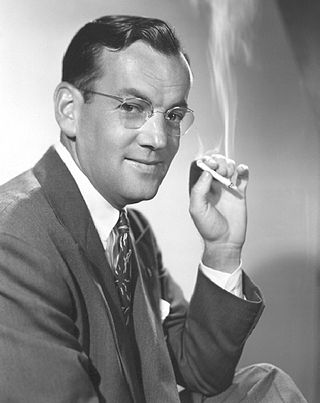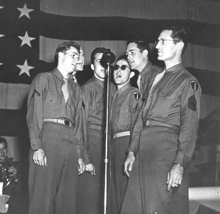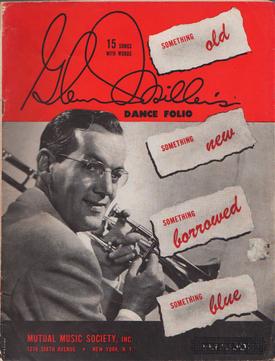
Alton Glen "Glenn" Miller was an American big band conductor, arranger, composer, trombone player, and recording artist before and during World War II, when he was an officer in the US Army Air Forces. His civilian band, Glenn Miller and His Orchestra were one of the most popular and successful bands of the 20th century and the big band era. His military group, the Major Glenn Miller Army Air Forces Orchestra, was also popular and successful.

"In the Mood" is a popular big band-era jazz standard recorded by American bandleader Glenn Miller. "In the Mood" is based on the composition "Tar Paper Stomp" by Wingy Manone. The first recording under the name "In the Mood" was released by Edgar Hayes & His Orchestra in 1938.

"Chattanooga Choo Choo" is a 1941 song written by Mack Gordon and composed by Harry Warren. It was originally recorded as a big band/swing tune by Glenn Miller and His Orchestra and featured in the 1941 movie Sun Valley Serenade. It was the first song to receive a gold record, presented by RCA Victor in 1942, for sales of 1.2 million copies.

Glenn Miller and His Orchestra was an American swing dance band formed by Glenn Miller in 1938. Arranged around a clarinet and tenor saxophone playing melody, and three other saxophones playing harmony, the band became the most popular and commercially successful dance orchestra of the swing era and one of the greatest singles charting acts of the 20th century. As of 2024, Ray Anthony is the last surviving member of the orchestra.

Gordon Lee "Tex" Beneke was an American saxophonist, singer, and bandleader. His career is a history of associations with bandleader Glenn Miller and former musicians and singers who worked with Miller. His band is also associated with the careers of Eydie Gormé, Henry Mancini and Ronnie Deauville. Beneke also solos on the recording the Glenn Miller Orchestra made of their popular song "In The Mood" and sings on another popular Glenn Miller recording, "Chattanooga Choo Choo". Jazz critic Will Friedwald considers Beneke to be one of the major blues singers who sang with the big bands of the early 1940s.

Sun Valley Serenade is a 1941 musical film directed by H. Bruce Humberstone and starring Sonja Henie, John Payne, Glenn Miller, Milton Berle, and Lynn Bari. It features the Glenn Miller Orchestra as well as dancing by the Nicholas Brothers. It also features Dorothy Dandridge, performing "Chattanooga Choo Choo", which was nominated for an Oscar for Best Song, was inducted into the Grammy Hall of Fame in 1996, and was awarded the first Gold Record for sales of 1.2 million.

"Serenade in Blue" is a 1942 Big Band song composed by Harry Warren, with lyrics written by Mack Gordon. It was introduced in the 1942 film Orchestra Wives by Glenn Miller and His Orchestra, sung by Lynn Bari in the film but dubbed by Pat Friday.
"Five Minutes More" is a 1946 American pop song written by Sammy Cahn (lyrics) and Jule Styne (music). It is sometimes referred to as "Give Me Five Minutes More". It was featured in the movie Sweetheart of Sigma Chi, sung by Phil Brito, and was a number one hit record in 1946 for Frank Sinatra.

Between 1938 and 1944, Glenn Miller and His Orchestra released 266 singles on the monaural ten-inch shellac 78 rpm format. Their studio output comprised a variety of musical styles inside of the Swing genre, including ballads, band chants, dance instrumentals, novelty tracks, songs adapted from motion pictures, and, as the Second World War approached, patriotic music.

The Crew Chiefs were a vocal group popular in the 1940s, known for accompanying Tex Beneke, Glenn Miller, and Ray McKinley. Member Artie Malvin co-wrote the song "I'm Headin' For California" with Glenn Miller in 1944.
Artie Malvin was a composer and vocalist who was the baritone member of The Crew Chiefs. He also sang with Glenn Miller's band.

"Doin' the Jive" is a 1938 song composed by Glenn Miller and pianist Chummy MacGregor. The song was released as a 78 single by Glenn Miller and His Orchestra on Brunswick.

"I Sustain the Wings" is a 1943 big band and jazz instrumental co-written by Glenn Miller. The instrumental was the theme for the eponymous radio program broadcast on CBS and NBC from 1943 to 1945.

"It Must Be Jelly ('Cause Jam Don't Shake Like That)" is a 1942 jazz and pop song recorded by Glenn Miller and His Orchestra. The song was released as an RCA 78 single by Glenn Miller in 1944. Woody Herman also released the song as a single and as a V-Disc.

"Here We Go Again" is a swing jazz instrumental recorded by Glenn Miller. The song was released as a 78 single. It was Glenn Miller's last Top 40 hit during his lifetime, peaking at #25.

"I Know Why " is a 1941 song by Glenn Miller and His Orchestra. The song appeared in the 20th Century Fox movie Sun Valley Serenade. The song was also released as an RCA Bluebird 78 single.

Glenn Miller is a compilation album of phonograph records released posthumously by bandleader Glenn Miller and His Orchestra. Released in 1945 on RCA Victor as a part of the Victor Musical Smart Set series, described on the front cover as "An Album of Outstanding Arrangements on Victor Records", the set was number one for a total of 16 weeks on the newly created Billboard album charts. The album, also known under the title Glenn Miller and His Orchestra, was certified Gold in July 1968 by the RIAA.

Glenn Miller Masterpieces, Volume II is an album by bandleader Glenn Miller, released on RCA Victor in 1947, consisting of a collection of four 10" 78 RPM discs, released as RCA Victor P189 as part of the RCA Victor Musical Smart Set series. The album was number one for a total of 6 weeks on the Billboard album charts in 1947. The collection was a follow-up to the 1945 compilation album Glenn Miller.
The Glenn Miller Orchestra is a band formed after the loss of Glenn Miller, named in memory of him and the original Glenn Miller Orchestra.

















